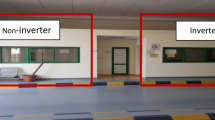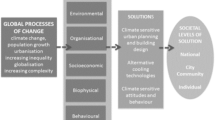Abstract
This study aims to investigate the operation performance of a new terminal form of radiant air-conditioning system called the air carrying energy radiant air-conditioning system (ACERS). Three summer operation conditions, namely steady condition (without opening door and window), open-door condition and open-window condition, are researched in a residential apartment using experimental, computational fluid dynamics (CFD) simulation and thermodynamic methods. The concept of dynamic synergistic operation of mechanical ventilation driven by the air-conditioning system and natural ventilation driven by the open door or window is proposed. A thermodynamic model formulated by the dynamic enthalpy equation, dynamic temperature equation and dynamic moisture equation is developed to analyze the heat and mass transfer process of the test room under the synergistic operation of mixing ventilation. Moreover, the CFD simulation results are used to analyze the synergistic operation and thermodynamic energy transfer of the test room under the mixing ventilation of ACERS and open door/window. It is indicated that ACERS is an important technology with a low temperature gradient of less than 0.1 °C between the head (1.5 m) and ankle level (0.1 m) and low velocity of approximately 0.1 m/s in the occupied zone under the steady condition. The thickness of the boundary zone under the orifice plate of ACERS under the steady, open-door and open-window conditions is 12, 6, and 8 cm, respectively, which can effectively prevent condensation. This study proves that ACERS is a promising technology for air conditioning in residential buildings in regions with hot and humid summers.
Similar content being viewed by others
References
Caciolo M, Stabat P, Marchio D (2011). Full scale experimental study of single-sided ventilation: Analysis of stack and wind effects. Energy and Buildings, 43: 1765–1773.
Celik IB, Ghia U, Roache PJ, Freitas CJ, Coleman H, Raad PE (2008). Procedure for estimation and reporting of uncertainty due to discretization in CFD applications. ASME Journal of Fluids Engineering, 130(7): 078001.
Chen K (2016). Design and optimization research of capillary radiant air conditioning system. Master Thesis, Xi’an Polytechnic University, China. (in Chinese)
Conceição EZE, Lúcio MMJR, Awbi HB (2013). Comfort and airflow evaluation in spaces equipped with mixing ventilation and cold radiant floor. Building Simulation, 6: 51–67.
Evola G, Popov V (2006). Computational analysis of wind driven natural ventilation in buildings. Energy and Buildings, 38: 491–501.
Fluent (2006). FLUENT User’s Guide Version 6.3. Fluent Inc.
Gan G (2000). Effective depth of fresh air distribution in rooms with single-sided natural ventilation. Energy and Buildings, 31: 65–73.
Gong G, Yang H, Su H, Wang C, Xu C (2013). The research on simplified algorithm of radiant heat transfer for air carry energy radiant air-conditioning terminal system. Journal of Hunan University (Natural Science), 40(12): 31–38. (in Chinese)
Gong G, Liu J, Mei X (2017). Investigation of heat load calculation for air carrying energy radiant air-conditioning system. Energy and Buildings, 138: 193–205.
He Y, Li N, Zhang W, Peng J (2016). Overall and local thermal sensation & comfort in air-conditioned dormitory with hot-humid climate. Building and Environment, 101: 102–109.
ISO (2005). ISO 7730-2005: Ergonomics of the thermal environment-Analytical determination and interpretation of thermal comfort using calculation of the PMV andPPD indices and local thermal comfort criteria. Geneva: International Organization for Standardization.
Jin W, Jia L, Gao P, Wang Q (2017). The moisture content distribution of a room with radiant ceiling cooling and wall-attached jet system. Building Simulation, 10: 41–50.
Li H, Gong G, Xu C, Su H, Cao Z, Zhou M, Yu CWF (2013). Thermal and humid environment and moisture condensation characteristics of cold surfaces. Indoor and Built Environment, 23: 474–484.
Liu Z, Zhang L, Gong G, Luo Y, Meng F (2015). Evaluation of a prototype active solar thermoelectric radiant wall system in winter conditions. Applied Thermal Engineering, 89: 36–43.
Liu H, Wu Y, Li B, Cheng Y, Yao R (2017). Seasonal variation of thermal sensations in residential buildings in the Hot Summer and Cold Winter zone of China. Energy and Buildings, 140: 9–18.
Mikeska T, Fan J, Svendsen S (2017). Full scale measurements and CFD investigations of a wall radiant cooling system integrated in thin concrete walls. Energy and Buildings, 139: 242–253.
Mustakallio P, Kosonen R, Korinkova A (2017). Full-scale test and CFD-simulation of radiant panel integrated with exposed chilled beam in heating mode. Building Simulation, 10: 75–85.
Sorgato MJ, Melo AP, Lamberts R (2016). The effect of window opening ventilation control on residential building energy consumption. Energy and Buildings, 133: 1–13.
Tang H, Liu X-H, Jiang Y (2016). Theoretical and experimental study of condensation rates on radiant cooling surfaces in humid air. Building and Environment, 97: 1–10.
Villarino JI, Villarino A, Fernández FÁ (2017). Experimental and modelling analysis of an office building HVAC system based in a ground-coupled heat pump and radiant floor. Applied Energy, 190: 1020–1028.
Wang H, Chen Q (2012). A new empirical model for predicting single-sided, wind-driven natural ventilation in buildings. Energy and Buildings, 54: 386–394.
Wu F (2015). Experimental research for application based on radiation terminal of air carrying and storing energy. Master Thesis, Hunan University, China. (in Chinese)
Wu Y (2011). Research on emission of ceiling radiant cooling panels and analysis of indoor thermal environment. Master Thesis, Hunan University, China. (in Chinese)
Xie D, Wang Y, Wang H, Mo S, Liao M (2016). Numerical analysis of temperature non-uniformity and cooling capacity for capillary ceiling radiant cooling panel. Renewable Energy, 87: 1154–1161.
Xu C, Gong G, Yang H, Gong S (2014). Numerical study of moisture condensation on pore panels of air-carrying energy radiation air-conditioning system. Building Science, 121(83): 79–84. (in Chinese)
Zhang C, Heiselberg PK, Chen Q, Pomianowski M (2017). Numerical analysis of diffuse ceiling ventilation and its integration with a radiant ceiling system. Building Simulation, 10: 203–218.
Acknowledgements
This work was supported by the National Key Technology Support Program (No. 2015BAJ03B00), the National Natural Science Foundation of China (No. 51378186), the National Special Program of International Cooperation and Exchange (No. 2010DFB63830).
Author information
Authors and Affiliations
Corresponding author
Rights and permissions
About this article
Cite this article
Liu, J., Gong, G., Liu, R. et al. Investigation of operation performance of air carrying energy radiant air-conditioning system based on CFD and thermodynamic model. Build. Simul. 11, 1229–1243 (2018). https://doi.org/10.1007/s12273-018-0454-8
Received:
Revised:
Accepted:
Published:
Issue Date:
DOI: https://doi.org/10.1007/s12273-018-0454-8




